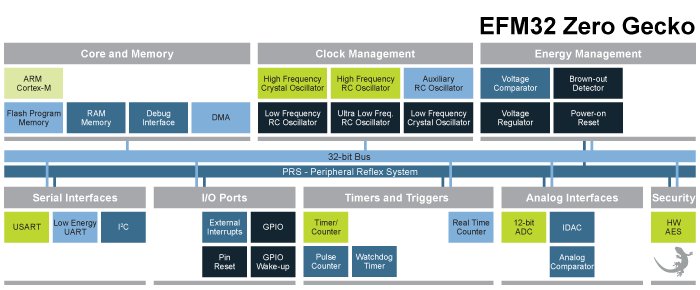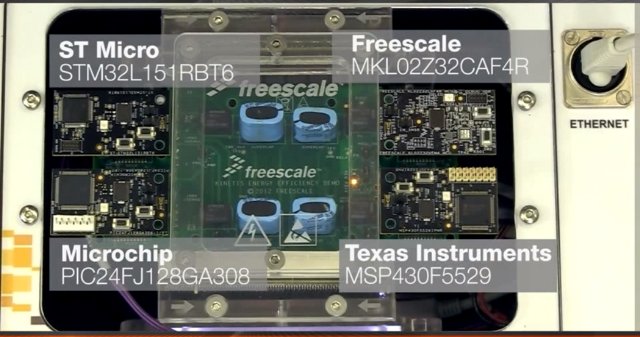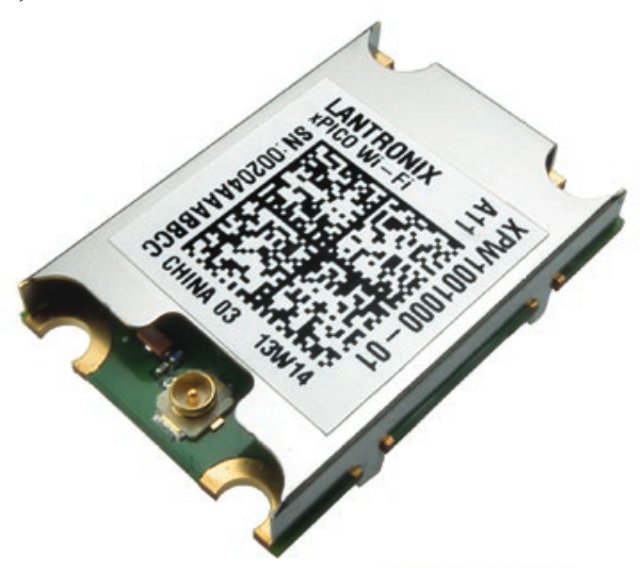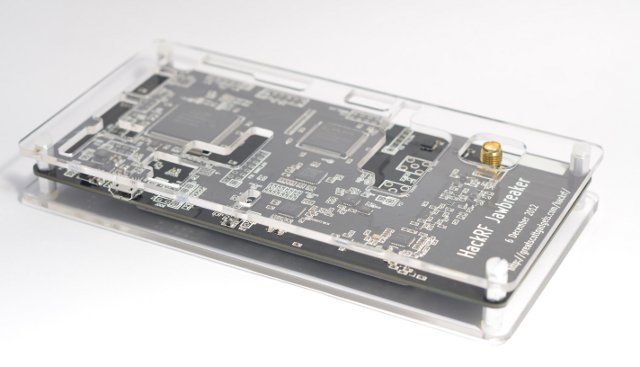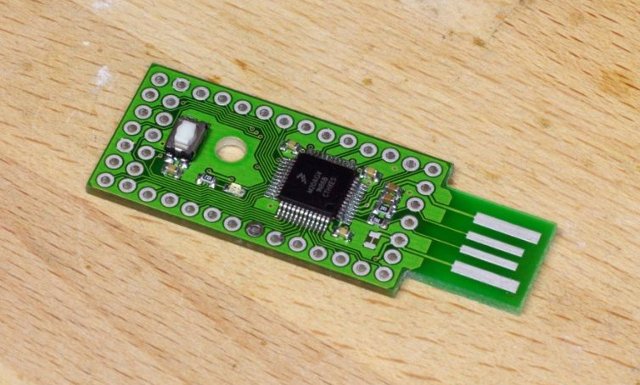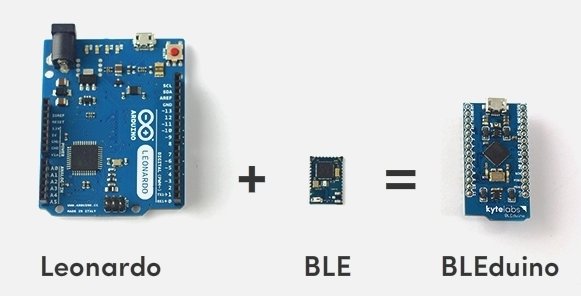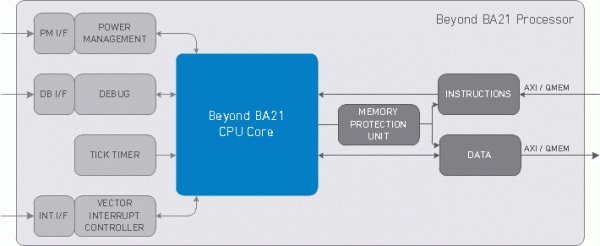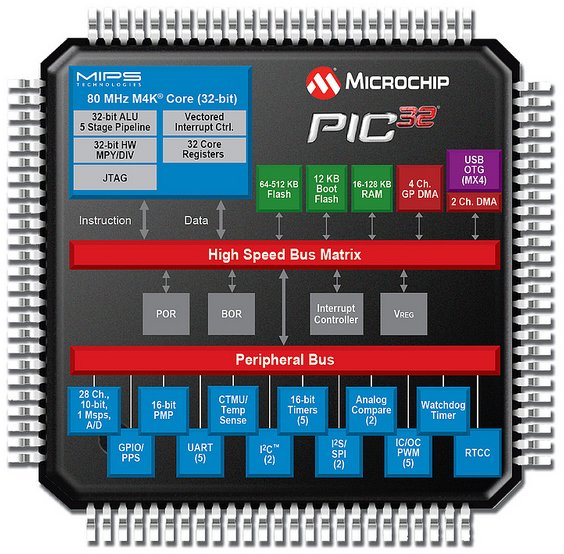Silicon Labs, who bought Energy Micro earlier this year, has recently introduced a new family of 32-bit MCU based on ARM Cortex M0+ called EFM32 Zero Gecko, as well as the corresponding starter kit. These ultra low power MCUs (currently 16 products) are destined to be used in IoT applications such as mobile health and fitness products, smart watches, activity trackers, smart meters, security systems and wireless sensor nodes, as well as battery-less systems powered by harvested energy. The key features of this family include: ARM Cortex-M0+ core @ 24 MHz 4kb to 32 kB flash and 2kb to 4 kB RAM memory 17 to 37 GPIO Single 1.85–3.8 V power supply 5 Power modes Hardware AES (Some models only) -40° to 85 °C operation range Package options: QFN24, QFN32 and QFN48 EFM32ZG222F32, the Zero Gecko MCU with the most memory and features, has the following specifications: ARM Cortex-M0+ CPU […]
MCU Energy Efficiency Benchmark – Freescale KL02, Microchip PIC24, TI MSP430, and STMicro STM32L
Freescale has recently uploaded a video comparison the energy efficiency of several micro-controllers: Freescale Kinetis KL02, Texas Instruments MSP430, STMicro STM32L, and Microchip PIC24. Since it’s a Freescale video, we already know the winner, but the test they performed it still interesting, and it shows drastic performance differences between architectures. The used the following exact MCU for testing: Freescale MKL02Z32CAF4R – Cortex M0+ @ 48 MHz STMicro STM32L151RBT6 – Cortex M3 @ 32 MHz Microchip PIC24FJ128GA308 – 16-bit MCU @ 32 MHz Texas Instruments MSP430F5529 – 16-bit MCU @ 25 MHz Freescale did not really select tough competition such as NXP LPC800 Cortex M0+, but instead a Cortex M3 MCU, and older 16-bit MCUs. I don’t know if Microchip has a new generation of ultra low power 16-bit MCUs , but Texas Instruments, for example, launched MSP430 Wolverine MCUs at the end of last year. So this comparison may not be […]
Lantronix Unveils xPico Wi-Fi Module For the Internet of Things
With Texas Instruments SimpleLink Wi-Fi CC3000 and Qualcomm Atheros AR4100P embedded Wi-Fi processors that fully handle Wi-Fi internally, and transfer data to an MCU with an SPI interface, and solutions such as Electric Imp, there are already ways to add Wi-Fi at relatively low cost to appliances. There’s now another solution available on the market with Lantronix xPico Wi-Fi Module. Listed features and specification of xPico Wi-Fi: SoC – ARM Cortex M3 class processor with 1MB on-chip Flash and 128 KB SRAM Storage – SPI Flash storage Wireless LAN Interface IEEE 802.11 b/g and IEEE 802.11n (single stream) WLAN interface (2.4 GHz only) IEEE 802.11 d/h/i/j/k/w/r WPS 2.0 support u.FL connector for external antenna Serial Interface Two Serial CMOS Ports (3.3V, 5V tolerant) 300 to 921.6 Kbps Flow control XON/XOFF, RTS/CTS (SPort 1 only) Lantronix tunneling application (SPort 1 only) Host Interface – Dual Serial Port, SPI, USB 2.0 (device), […]
$275 HackRF Open Source Software Defined Radio (SDR) Platform
HackRF is an open source hardware project to build a Software Defined Radio (SDR) supporting a frequency range between 30 MHz and 6GHz in both directions (Tx and Rx, half-duplex) with a maximum bandwidth of 20MHz. Jawbreaker (shown below) is a beta hardware that has been tested by several developers and beta testers, and applications such as Digital Audio Broadcasting (DAB), Bluetooth monitoring, spectrum sensing, wireless microphones, AIS, FM radio, etc.. have already been ported to the platform. In order to lower the cost of the hardware, Michael Ossmann has launched a Kickstarter campaign to fund mass production. There seems to be many SDR enthusiasts as the campaign has already reached its funding target ($80,000) and received for over $300,000 in ledges. What is Software Defined Radio (SDR) and What Can it Be Used for? Before providing details about the hardware and software, it may be useful to provide some […]
MC HCK is a $5 ARM Development Board Powered by Freescale K20 MCU
MC HCK (pronounced McHack) is a tiny and cheap development board powered by Freescale K20 MCU (ARM Cortex M4) that can be easily programmed via USB. The board has been designed with KiCad, is fully open source hardware, and it’s supposed to cost as low as $5. The only problem, or main advantage, depending on how you look at it, is that it’s not available for sale (yet), but instead you’ll need to make it yourself. The actual cost of doing so will be well over $5 (About $35), but the BoM cost is about $5, and you can make 5 boards for this price, or about $7 per board. The detailed steps are explained on McHck blog, but they can summarized as follows: Order 10 PCB using the gerber files via services such as Seeedstudio or Iteadstudio Order 5 free samples of Freescale K20 MCU. Select MK20DX128VLF5 part, and […]
$34 BLEduino Bluetooth 4.0 Low Energy Arduino-Compatible Board
After RFDuino, here’s another tiny low cost Bluetooth 4.0 SMART development board compatible with Arduino. BLEduino board is the merger of Arduino Leonardo and Bluetooth module, features Atmel ATmega32u4 MCU, Nordic Semi nRF8001 for BLE, and includes an on-board USB programming interface. Key features of BLEduino board: MCU – Atmel ATmega32u4 @ 16 MHz with 32 KB flash, 2.5 KB SRAM, and 1 KB EEPROM Power Supply – 5V. Onboard 5V & 3.3V regulators I/O: 21x GPIO Pins 6x PWM Channels 12x Analog Input Channels Serial Communication – UART, SPI, I2C LED – RX/TX for serial communication, LED for Bluetooth connectivity Bluetooth – Version 4.0 with Low Energy sypport via Nordic Semi nRF8001. Expected range: at least 24 meters Dimensions – Around 22.8 x 43.2 mm Kytelab, the company behind BLEduino, also provides “Shield-Shield”, a baseboard that translates BLEduino’s pin layout into the traditional Arduino layout, and allows you to […]
Beyond Semiconductor Announces BA21 Processor Core for Embedded MCUs
Beyond Semiconductor, a Ljubljana, Slovenia based company, has recently announced BA21, a 32-bit processor core, with 2.5 Coremark per megahertz, and clocked up to 125 MHz, that’s roughly equivalent to a Cortex M3 core @ 120 MHz. Target applications include mixed signal embedded processing, wireless communications ICs (e.g. Bluetooth, Zigbee, GPS), industrial Microcontrollers, and battery-powered or ultra-low-cost devices.If you’ve never heard about Beyond Semi, you may want to read my previous article about their BA25 core (Cortex A7/A8 equivalent) for a bit more details about the company. Here are the key features of BA21 core: 32-bit Processor Small silicon footprint (less than 10k gates) for lower leakage and dynamic CPU power Two-stage pipeline architecture Extreme Code Density for lower instruction fetching energy Advanced power management Dynamic clock gating and power shut-off of unused units Software- and hardware-controlled clock frequency Wake-up on tick timer or external interrupt Performance Up to 2.5 […]
Microchip Announces New PIC32MX3/4 32-bit MCUs Based on MIPS M4K Core
Microchip Technology has just announced a new family of PIC32MX3/4 MCUs featuring a MIPS M4K core @ 80 MHz, coupled with 16 to 128KB RAM, 64 to 512KB flash, that are designed to be used in connectivity, graphics, digital audio and general-purpose embedded control. Microchip PIC32MX3/4 32-bit micro-controllers have been available for several years, but the company added 7 new MCUs with more memory, higher integration of peripherals, and lower cost. PIC32MX3/4 key features are as follows: MIPS M4K core @ 80 Mhz with 105 DMIPS performance (equivalent to Cortex M3 MCU @ 84MHz), 16 to 128KB RAM, 64 to 512KB flash, and 12KB boot flash. 4 channel GP DMA, 2 channel DMA I/O: 28 channels 10-bit ADCs 5x UARTS, 2x I2C, 2x I2S/SPI, GPIOs 5x PWM 16-bit parallel master port (PMP) Charge Time Measurement Unit (CTMU)/Temperature Sensor 5x 16-bit timers, watchdog timer, Real-time clock USB OTG (MX4 family only) […]


